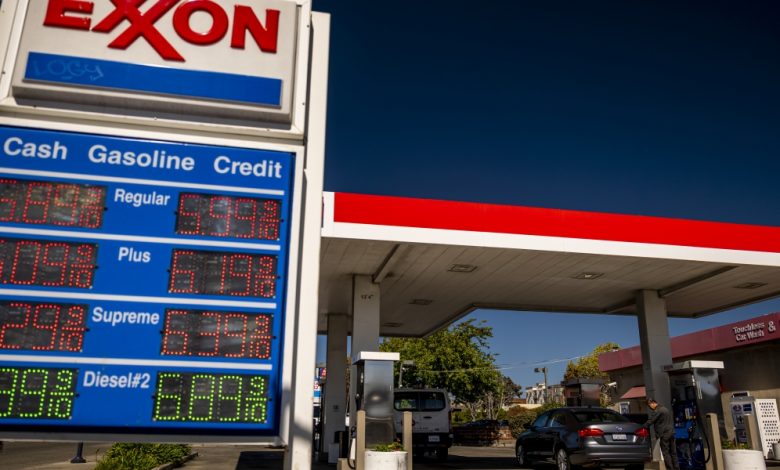Exxon Mobil’s record profit of $55.7 billion last year has fueled criticism that it was profiting from the Ukraine war and sky-high gas prices

Exxon Mobil posted record annual profits in 2022 as consumers around the world grappled with high prices for gas, heating and consumer goods.
The energy giant posted annual profits of $55.7 billion, surpassing its previous record of $45.22 billion set in 2008, when a barrel of oil rose to nearly $150.
Exxon’s bounty came as Americans shelled out over $4 a gallon for gas for much of the spring and summer, and millions of them hit the streets. At one point, gasoline topped $5 a gallon. Supplies tightened and prices rose globally after Russia invaded Ukraine and cut energy supplies to Europe.
The year marked a dramatic turn from 2020, when travel ground to a halt during the coronavirus pandemic and demand for fuel evaporated. At times this year, the price of future oil contracts plunged below zero, dozens of oil and gas companies filed for bankruptcy protection, and thousands of industrial workers lost their jobs. Exxon lost money in 2020 for the first time in decades.
Two years later, Exxon posted $12.75 billion in profit and $95.43 billion in revenue in its most recent quarter alone.
“While our results clearly benefited from a favorable market, the counter-cyclical investments we made before and during the pandemic provided the energy and products people needed as the economy began to recover and supplies became scarce.” , said CEO Darren Woods. “We leaned in when others leaned out.”
Exxon achieved its best-ever annual refining output in North America and the highest globally since 2012, the company said. The company has completed the expansion of its Beaumont refinery in Texas and expects to process 250,000 barrels per day of crude oil there in the first quarter of this year.
Much of the country’s refining capacity, which was taken offline during the pandemic, has yet to return, Woods said during a conference call with investors, pushing up refining margins.
“We continued to strengthen our industry-leading portfolio and increased production from high-yield, favored assets in Guyana and the Permian at a time when the world needed it most,” said Woods.
Exxon earned $3.09 per share for the quarter. That was less than expectations from analysts polled by Factset, who had been expecting $3.29 per share.
Oil prices fluctuated between $70 and $90 a barrel of US crude during the quarter. Domestic natural gas prices, which affect the cost of energy and electricity at home, ranged between $6 and $7 per million British thermal units in the quarter, according to FactSet, which was a higher price than most Americans paid in recent years to have.
Since Russia invaded Ukraine, Russia has reduced its natural gas supplies to Europe, leading to higher prices for natural gas and its liquid counterpart LNG on the world market.
President Joe Biden has accused oil companies of profiting from the war Russia is waging against Ukraine and has previously raised the possibility of a war profits tax for oil companies. Exxon said it incurred $1.3 billion in the quarter related to European energy taxes and asset impairments.
“An unexpected tax on oil and gas profits is needed more than ever to free up money much needed to help those struggling with energy costs as economies around the world grapple with recession,” said Jonathan Noronha-Gant, senior campaigner with Global Witness, a nonprofit organization dedicated to environmental sustainability and corporate responsibility.
The European Union imposed a windfall tax on energy companies last fall, and Exxon filed a lawsuit challenging the tax in December.
“We looked at what happened in the EU and said it’s not legal and the opposite of what is needed,” Woods said on Tuesday. “So what is needed now is more supply. And instead what has been introduced is a punishment for the broader energy sector.”
Exxon also announced progress on sustainability goals, saying it met its goal to eliminate routine flaring in the Permian Basin in the fourth quarter, part of its efforts to reduce emissions. Flaring is a practice by which oil and gas companies burn excess natural gas instead of capturing it.
Exxon’s Low Carbon Solutions business recently signed a contract to capture and permanently store up to 2 million tons of carbon dioxide per year, Woods said. The recent passage of the Inflation Mitigation Act, which incentivizes carbon capture and storage, bolsters those plans, and Exxon plans to invest $17 billion in lower-emission opportunities from 2022 to 2027, up from $15 billion in the previous plan, he said.
Exxon ended 2022 on a strong note, but lower oil and natural gas prices in the fourth quarter — compared to earlier in the year — had an impact, said Peter McNally, global sector head at Third Bridge. “The big picture for Exxon Mobil is that the company has financial flexibility and many investment opportunities,” McNally added.
Learn how to navigate and build trust in your organization with The Trust Factor, a weekly newsletter exploring what leaders need to succeed. Sign up here.



